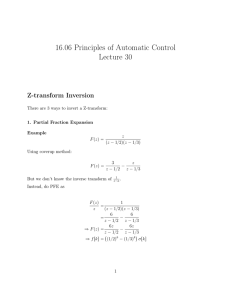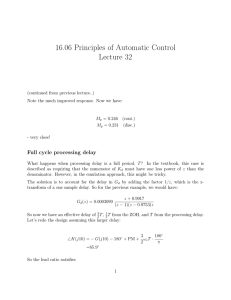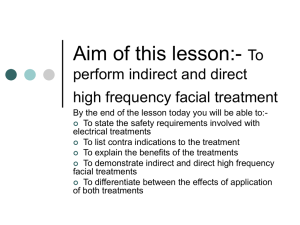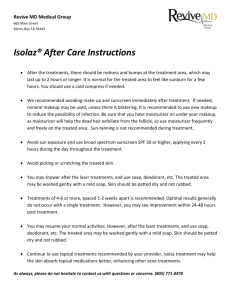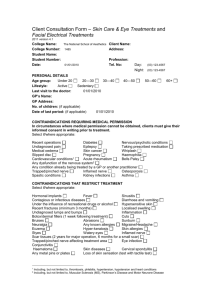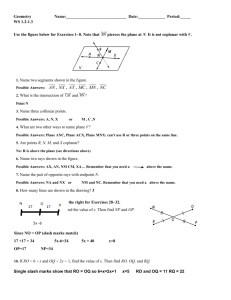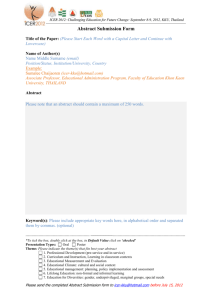Mock_Manuscript2
advertisement
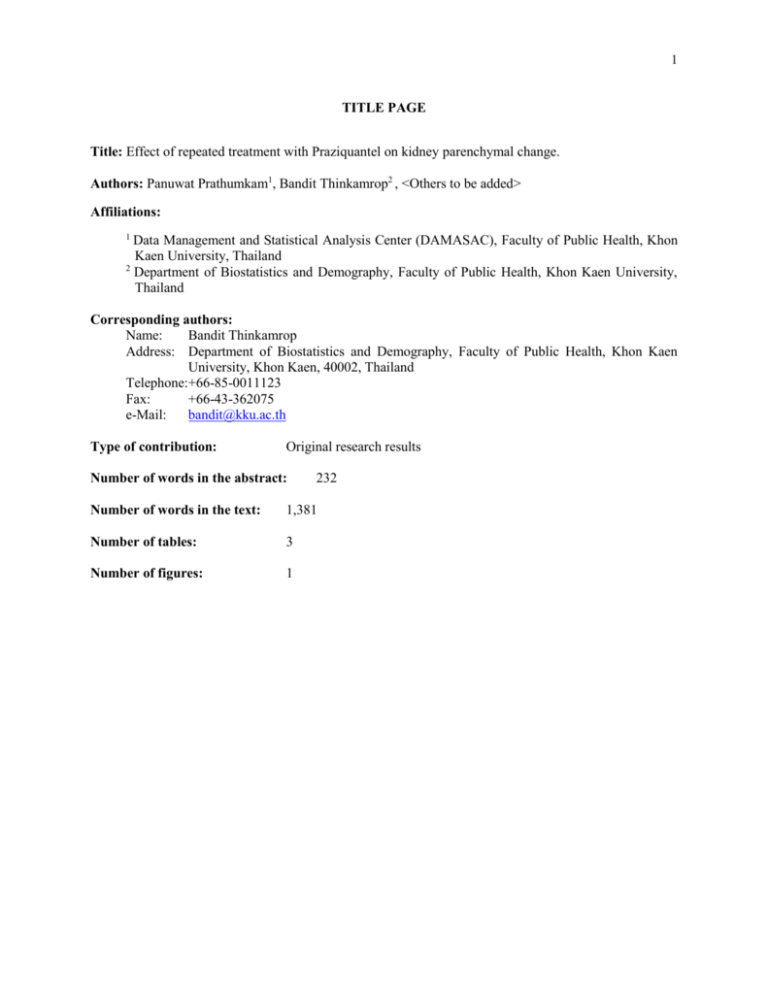
1 TITLE PAGE Title: Effect of repeated treatment with Praziquantel on kidney parenchymal change. Authors: Panuwat Prathumkam1, Bandit Thinkamrop2 , <Others to be added> Affiliations: 1 Data Management and Statistical Analysis Center (DAMASAC), Faculty of Public Health, Khon Kaen University, Thailand 2 Department of Biostatistics and Demography, Faculty of Public Health, Khon Kaen University, Thailand Corresponding authors: Name: Bandit Thinkamrop Address: Department of Biostatistics and Demography, Faculty of Public Health, Khon Kaen University, Khon Kaen, 40002, Thailand Telephone:+66-85-0011123 Fax: +66-43-362075 e-Mail: bandit@kku.ac.th Type of contribution: Original research results Number of words in the abstract: 232 Number of words in the text: 1,381 Number of tables: 3 Number of figures: 1 2 ABSTRACT Background: Praziquantel (PZQ) has been the mainstay of liver-fluke control. Favorite raw fermented or uncooked fish in northeast of Thailand caused re-infections and repeated treatments. Since PZQ and its metabolites are excreted in the kidney. However, Nephrotoxic effects of PZQ are unknown. Objective: To investigate a relationship between repeated treatments with PZQ and kidney parenchymal change. Methods: A cross-sectional study was carried out on participants from the Cholangiocarcinoma Screening and Care Program (CASCAP). Subjects were 40 years or older, had been infected with liverfluke or had been treated with PZQ. Kidney parenchymal change was diagnosed by ultrasonography. Number of treatments with PZQ and other potentially confounding factors that associated with kidney abnormality were determined by odds ratio (ORs) and 95% confidence interval (95%CI) using multiple logistic regression. Results: Among 56,555 subjects with a mean age of 53.8 (±9.45) years, 57.9% were female. The overall prevalence of treatment with PZQ was 43.6% (95%CI: 43.2 to 44.0). Compared with non-treatment, one treatment (OR 1.13; 95%CI: 1.04 to 1.23), two treatments (OR 1.33; 95%CI: 1.16 to 1.52), three treatments (OR 1.56; 95%CI: 1.21 to 2.00) and more than three treatments (OR 1.70; 95%CI: 1.40 to 2.07) with adjusted for all other factors including age, gender, diabetes mellitus and alcohol consumption. Conclusions: Repeated treatment with PZQ may cause kidney parenchymal change. The necessity for policy change to provide health education about realization and prevention on repeated treatment with PZQ. Keywords: praziquantel, repeated treatment, kidney parenchymal change, renal parenchymal change. 3 INTRODUCTION Opisthorchis viverrini (OV), common name Southeast Asian liver-fluke, is a parasite from Opisthorchiidae family. OV infection was acquired when people eat raw or undercooked fish[1] and endemic throughout Thailand, Lao People's Democratic Republic, Vietnam and Cambodia[2]. In Northeast Thailand - a highest incidence of liver-fluke infection and Cholangiocarcinoma (CCA) in the world, Praziquantel (PZQ) has been the mainstay of anthelmintic for liver-fluke control and widely distributed. Raw fish and fermented fish in several favorite dishes across this region caused high re-infections and repeated treatments with PZQ [3]. In pharmacokinetic, PZQ was found to concentrate especially in the liver and kidneys[4]. Since 80% of PZQ and its metabolites are excreted in the kidneys[5]. However, little is known about effects of repeated treatment with PZQ on kidney parenchymal change (KPC). This study aimed to investigate a relationship between repeated treatments with PZQ and KPC. MATERIALS AND METHODS Study design This study was conducted at primary and secondary hospitals around 21 provinces in Northeast Thailand as part of the Cholangiocarcinoma Screening and Care Program (CASCAP, www.cascap.in.th). All people in risk group who have age more than 40 years and have been infected or treated with liverfluke were carried out in 2013-2015 as a cross-sectional data. Subjects with incomplete information were excluded. A total 57,687 subjects were included in the analysis. Study outcome Ultrasound examinations were performed in secondary hospital by doctor or radiologist. The type and classification of kidney abnormality were defined as renal cyst, parenchyma change, post nephrectomy and renal stone. Statistical analysis Demographic characteristics of subjects were described using frequency and percentage for categorical data such as gender, age, education level, occupation, smoking, alcohol consumption and diabetes mellitus. For continuous data such as age of subjects was described by mean, standard deviation, median, minimum and maximum. Prevalence of KPC was calculated in percentage based on a normal approximation to the binomial distribution. Number of treatments with PZQ and other potentially confounding factors that associated with KPC were determined by odds ratio (ORs) and 95% confidence intervals (95%CIs) using multiple logistic regression. All analysises were performed using R version 3.2.2 (The R foundation for statistical computing). All statistics test were two-sided and a p-value of less than 0.05 was considered statistical significant. This project was approved by ……. 4 RESULTS A total 105,919 subjects were registered in CASCAP database. From the 60,281 subjects who had Ultrasound examination results, there were 3,726 subjects excluded from the study due to incomplete information of data, hence 56,555 subjects were included in the analysis (Fig.1) Figure 1. Classification diagram All subjects in CASCAP Database n = 105,919 Exclude due to no U/S diagnosis. n = 45,638 Ultrasonography Screening n = 60,281 Exclude due to incomplete info. n = 3,726 Included in analysis n = 56,555 Never had treatment with PZQ n = 31,592 (56.4%) Had treatment with PZQ n = 24,436 (43.6%) 5 Demographic Characteristics Among 56,555 subjects with a mean age 53.8 (±9.4) years ranging from 25.2 to 99.8 years. More than half of them were female (57.9%), and most of them graduated from primary school (74.7%) and work as farmer (79.9%) (Table 1.) Table 1. Demographic and characteristic Characteristics Gender Male Female Age in years Less than 40 40 to 44 45 to 49 50 to 54 55 to 59 60+ Mean (±SD) Median (Min : Max) Education level None Primary Secondary (M1) Secondary (M2) Certificate Bachelor Higher than bachelor Occupation Unemployed Farmer Labor Own business Government official/State enterprises Others Smoking No Yes Alcohol consumption No Yes, current or previous Diabetes Mellitus No Yes Number Percent 23,739 42.1 32,685 57.9 1,083 9,069 10,417 10,093 8,524 13,235 53.8 52.8 2.1 17.3 19.9 19.3 16.3 25.3 ±9.4 (25.2 : 99.8) 500 41,902 4,275 5,051 882 2,625 846 0.9 74.7 7.6 9.0 1.6 4.7 1.5 1,373 44,803 3,164 1,686 3,386 1,678 2.5 79.9 5.6 3.0 6.0 3.0 42,623 76.5 13,078 23.5 31,029 54.9 25,526 45.1 53,694 94.9 2,861 5.1 Prevalence of Kidney Parechymal Change (KPC) From 56,555 subjects, the overall prevalence of KPC was 5.9%. KPC was found in 8.4% in male, but only 4.1% in female. Prevalence of KPC was linearity increased from 5.2%, 6.2%, 7.5%, 7.8% and 9.7% for none, one, two, three and more than three treatments with PZQ. The association between Number of treatments with PZQ and KPC from crude analysis were highly significant compared with 6 none treatments: one treatment (OR 1.20; 95%CI: 1.11 to 1.30), two treatments (OR 1.52; 95%CI: 1.34 to 1.74), three treatments (OR 1.82; 95%CI: 1.43 to 2.30) and more than three treatments (OR 1.95; 95%CI: 1.61 to 2.35). Other factors were significant associated such as gender, age, education level, occupation, smoking, alcohol consumption and diabetes mellitus. (Table 2) Table 2. Prevalence of kidney parenchymal change and odds ratio of the factors. Factors Overall Number of treatment with PZQ None One Two Three More than three Gender Male Female Age Less than 40 40 to 44 45 to 49 50 to 54 55 to 59 60+ Age in years Education level None Primary Secondary (M1) Secondary (M2) Certificate Bachelor Higher than bachelor Occupation Unemployed Farmer Labor Own business Government Others Smoking No Yes Alcohol consumption No Yes, current or previous Diabetes Mellitus No Yes Number % KPC 56,555 5.9 29,850 18,634 3,625 857 1,320 5.2 6.2 7.5 7.8 9.7 1 1.20 1.52 1.82 1.95 23,739 32,685 8.4 4.1 1 0.47 1,083 9,069 10,417 10,093 8,524 13,235 1.8 3.3 4.0 4.9 6.4 10.3 1 1.93 2.30 2.91 3.86 6.44 1.051 1.21 – 3.08 1.45 -3.66 1.83 – 4.63 2.43 – 6.12 4.08 – 10.17 1.05 – 1.06 0.70 – 1.46 0.55 – 1.19 0.54 – 1.16 0.54 – 1.39 0.40 – 0.92 0.28 – 0.82 Crude OR 95% CI p-value <0.001 1.11 – 1.30 1.34 – 1.74 1.43 – 2.30 1.61 – 2.35 <0.001 0.44 – 0.51 <0.001 500 41,902 4,275 5,051 882 2,625 846 6.2 6.3 5.1 5.0 5.4 3.9 3.1 1 1.01 0.81 0.79 0.87 0.61 0.48 1,373 44,803 3,164 1,686 3,386 1,678 8.7 6.0 6.0 4.3 3.8 6.2 1 0.67 0.66 0.47 0.41 0.69 42,623 13,078 5.0 8.7 1 1.80 31,029 25,526 5,0 7.0 1 1.43 53,694 2,861 5.7 9.6 1 1.75 <0.001 <0.001 <0.001 0.55 – 0.81 0.52 – 0.84 0.35 – 0.64 0.32 – 0.53 0.53 – 0.91 <0.001 1.67 – 1.94 <0.001 1.33 – 1.53 <0.001 1.53 – 1.99 7 Factors associated with kidney parenchymal change. Using multiple logistic regressions, the association between number of treatments with PZQ and KPC was adjusted for all other factors including gender, age, alcohol consumption, and diabetes mellitus. The risk of number of treatments with PZQ still remained significant compared with none treatments: one treatment (OR 1.13; 95%CI: 1.04 to 1.23), two treatments (OR 1.33; 95%CI: 1.16 to 1.52), three treatments (OR 1.54; 95%CI: 1.21 to 2.00) and more than three treatments (OR 1.70; 95%CI: 1.40 to 2.07). (Table 3.) Table 3. Adjusted odds ratio of factors associated with kidney parenchymal change. Factors Overall Number of treatment with PZQ None One Two Three More than three Gender Male Female Age in years Alcohol consumption No Yes, current or previous Diabetes Mellitus No Yes Education level None Primary Secondary (M1) Secondary (M2) Certificate Bachelor Higher than bachelor Number % KPC 56,555 5.9 29,850 18,634 3,625 857 1,320 23,739 32,685 Crude OR Adj. OR 95% CI 5.2 6,2 7.5 7.8 9.7 1 1.20 1.52 1.82 1.95 1 1.13 1.33 1.54 1.70 8.4 4.1 1 0.47 1.05 1 0.54 1.05 0.50 – 0.59 1.04 – 1.05 1.06 – 1.26 pvalue <0.001 1.04 – 1.23 1.16 – 1.52 1.21 – 2.00 1.40 – 2.07 <0.001 31,029 25,526 5,0 7.0 1 1.43 1 1.16 53,694 2,861 5.7 9.6 1 1.75 1 1.58 500 41,902 4,275 5,051 882 2,625 846 6.2 6.3 5.1 5.0 5.4 3.9 3.1 1 1.01 0.81 0.79 0.87 0.61 0.48 1 1.30 1.30 1.23 1.19 0.93 0.82 <0.001 <0.001 <0.001 1.38 – 1.80 0.007 0.88 – 1.92 0.86 – 1.97 0.81 – 1.86 0.72 – 1.97 0.60 – 1.45 0.47 – 1.42 8 DISCUSSIONS Explaining the findings <copy narrative parts of the Results followed by explaining each important findings in turn , 5-10 references needed here in this section where about half of them are the same as the one cited in the Introduction section of the manuscript> Strength of the study <to be written> Limitation of the study Can selection bias distort the findings? o Selection bias Can information bias distort the findings? o Recall bias Can confounding bias distort the findings? Conclusions There was association between number of treatment with PZQ and kidney parechymal change. Repeated treatment with PZQ may cause kidney parechymal change. The necessity for policy change to provide health education about realization and prevention on repeated treatment with PZQ. Recommendations <to be written> Acknowledgements: Funds: [5-7] 9 REFERENCES 1. 2. 3. 4. 5. 6. 7. Laha T, Pinlaor P, Mulvenna J, Sripa B, Sripa M, Smout MJ, Gasser RB, Brindley PJ, Loukas A: Gene discovery for the carcinogenic human liver fluke, Opisthorchis viverrini. BMC genomics 2007, 8:189. Young ND, Campbell BE, Hall RS, Jex AR, Cantacessi C, Laha T, Sohn WM, Sripa B, Loukas A, Brindley PJ et al: Unlocking the transcriptomes of two carcinogenic parasites, Clonorchis sinensis and Opisthorchis viverrini. PLoS neglected tropical diseases 2010, 4(6):e719. Hinz E, Saowakontha S, Pipitgool V: Opisthorchiasis control in northeast Thailand: proposal for a new approach. Applied parasitology 1994, 35(2):118-124. Olliaro P, Delgado-Romero P, Keiser J: The little we know about the pharmacokinetics and pharmacodynamics of praziquantel (racemate and R-enantiomer). The Journal of antimicrobial chemotherapy 2014, 69(4):863-870. Patzschke K, Putter J, Wegner LA, Horster FA, Diekmann HW: Serum concentrations and renal excretion in humans after oral administration of praziquantel--results of three determination methods. European journal of drug metabolism and pharmacokinetics 1979, 4(3):149-156. Devidas A, Lamothe F, Develoux M, Mouchet F, Sellin B: Ultrasonographic assessment of the regression of bladder and renal lesions due to Schistosoma haematobium after treatment with praziquantel. Annales de la Societe belge de medecine tropicale 1989, 69(1):57-65. Chen MG, Fu S, Hua XJ, Wu HM: A retrospective survey on side effects of praziquantel among 25,693 cases of schistosomiasis japonica. The Southeast Asian journal of tropical medicine and public health 1983, 14(4):495-500.
